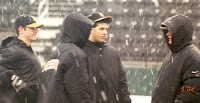 E
E is for
East
Word is that Missouri will be playing in the East Division of the SEC, mostly because Alabama and Auburn don't want to be separated.
The three schools that were considered the best in the SEC for much of the 70s, 80s and 90s are all in the West Division: Alabama, LSU and Mississippi State. However, the West's dominance appears to be a thing of the past.
In 2011, the West was greatly overshadowed by East. Three SEC East schools finished in the Top 10 of the RPI rankings; 4 SEC East teams and 2 SEC West teams were in the top 20
With the rise to power of South Carolina, Florida and Vanderbilt as dominant players nationally, the West has failed to keep up. See
Around the Bases Looks at the Future of SEC Baseball (TeamSpeedKills.com)
On the other hand, the two schools most often in the SEC cellar are Tennessee and Kentucky, both in the East.
Then again, Tennessee has a hired a new coach beginning this fall: Dave Serrano, who has taken both UC-Irvine and Cal State-Fullerton to the College World Series.
The upshot is that it really doesn't make much difference in the long term which division Mizzou is in, because the entire conference is pretty tough and the winds of fortune will change.
Schedule
I've not heard yet how the SEC Baseball schedule will be set up now that there are 14 teams, but I can make a good guess.
Currently, each team's schedule features 10 weekend conference 3-game series: 5 series against teams within their division, and 5 against teams from the opposite division. Under that system, an SEC team plays every other SEC team except one.
Arkansas, for example, is scheduled to play every team except Vanderbilt in 2012 (which is odd, considering Vandy is one of the closest to Little Rock geographically).
With two new teams in the conference, my guess would be the system will be similar. The goal of the schedule is still a legitimate one - limiting the fixed conference schedule to 10 match-ups, leaving sufficient room in the schedule for out-of-conference weekend series. In 2012, Arkansas has 4 non-conference weekends (Villanova, Valparaiso, the Houston College Classic, and Binghamton) prior to the beginning of the SEC schedule on March 16th, with no bye-weekend in the middle of the SEC schedule.
With 14 teams, that would mean each team would play 6 series versus their divisional rivals and 4 series against the opposite division. Which means there would be 3 teams each season that aren't on your schedule.
For MU, that would mean a weekend 3-game series vs. Vanderbilt, Kentucky, Tennessee, South Carolina, Florida and Georgia each season, plus 4 series against an annual rotation of 4 among Arkansas, Texas A&M, Ole Miss, Mississippi State, LSU, Auburn and Alabama.
According to
an article this past week in the Columbia Tribune, "Jamieson said the league is expected to continue playing 30 conference games, with six division series and four rotating interdivision series, though it has not been finalized."
For more on the geographical layout of the new SEC, check back in here Thursday morning:
G is for Geography















